This section contains some basic information about the single most important part of television production equipment, the camera. Specifically, we will discuss these major points:
1. The parts of the camera, including the lens, the actual camera head with the major pickup tubes and the viewfinder, and the major units of the CCU the camera control unit.
2. How the camera works, or the conversion of light into electrical signals.
3. The black-and-white, or monochrome, camera; in particular, its major camera pickup tubes and its operational and electronic characteristics.
4. The color camera, with a discussion of chrominance and luminance channels, internal optical system, color separation, and operational and electronic characteristics.
5. The major types of cameras and the principal use of each.
Almost everything you can see on your television set has been pre-seen by a television camera. The pictures that appear on your screen are determined by what the television camera can see and how it sees it. For example, when you are out for a walk, a typical night scene will look perfectly acceptable to your eyes. You may be able to see quite distinctly parts of buildings, doorways, lighted windows, some people walking along the sidewalk, the cars going by. The illumination by streetlamps, car headlights, and lighted shop windows, which seems adequate for your eyes, may, however, prove utterly inadequate for the television camera. The scene will then appear muddy and unclear on the screen, if it reproduces at all.
In fact, most other television production equipment and production techniques are either directly determined by what the camera can and cannot do, or at least greatly influenced by it. The use of microphones and lighting instruments, the way the performers move and talk, even the art of writing and directing-are all greatly influenced by, if not dictated by, the camera's capability and versatility.
In this section, we will cover these major points: (1) parts of the monochrome (black-and-white) and the color camera, (2) the operational and electronic characteristics of the camera, and (3) the various types of television cameras.
Parts of the Camera
The standard television camera consists of three main parts (see 2.1): (1) the lens, which selects a certain field of view and produces a small optical image of this view. The lens and certain attachments to it are called the external optical system; (2) the camera itself with its camera pickup tubes and internal optical system, which converts the optical image produced by the lens into electrical signals; and (3) the viewfinder, which converts these electronic signals back into a visible screen image.
The camera, which combines the lens, the pickup tubes and internal optical system, and the viewfinder, is called the camera head, since it is at the head of a chain of other essential electronic camera control equipment (see 2.4). The camera head itself has a series of attachments and controls that helps the operator use the camera efficiently and creatively (see 2.2 and 2.3).
How the Camera Works
Most cameras have remotely controlled, or even automatic, features that make them relatively easy to operate in the studio or on remote location without much understanding of their intricate electronics. However, since almost all production equipment and production procedures are dependent to a large extent on what the camera can and cannot do, a thorough knowledge of at least the basic workings and electronic characteristics seems a desirable prerequisite to effective television production.

2.1 Basic Parts of the Television Camera.
2.2 Philips LDK-25 Color Camera.
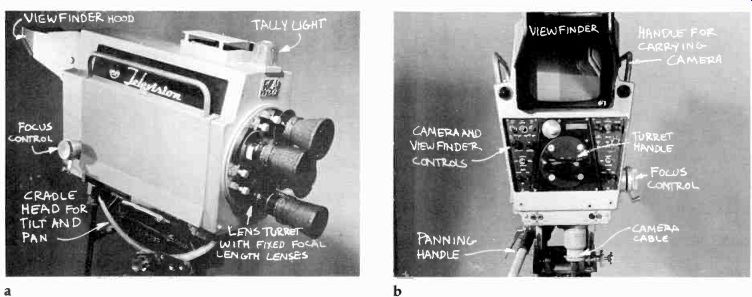
2.3 RCA TK-60 Monochrome Turret Camera: (a) side view; (b) rear view.
All television cameras, whether they are color or monochrome, big studio models or small portable ones, work on the same basic principle: the conversion of an optical image into electrical signals that are reconverted by a television set into visible screen images. (See 2.5.) Specifically, the light that is reflected off an object (a) is gathered by the camera lens (b) and focused on the front surface of the camera pickup tube (c). The pickup tube is the principal camera element that transforms the light into electrical energy, called the video (picture) signal. The very weak video signal from the pickup tube is then strengthened by the preamplifiers (d) and sent through a cable to the camera control unit (CCU). From there, the properly adjusted picture is distributed to the monitors (television sets) in the studio and control rooms, and ultimately to the transmitter. Also, the video signal is sent back to the camera viewfinder (e) so that you can see exactly what your camera is photographing.
The Monochrome (Black-and-White) Camera
Although the color camera is used exclusively in professional broadcast operations, and frequently in non-broadcast television productions, you should still know about the major types of monochrome cameras and their basic differences. First, large studio-type monochrome cameras are still used in many colleges and universities. Second, most of the popular and inexpensive portable cameras are black-and-white. Third, the color camera, though more complicated than the black-and-white, nevertheless works in quite similar ways.
In the monochrome camera, white light (which is a combination of all colors) enters the camera.
Since the picture is monochrome, of one color only (shades of gray ranging from black to white), we need only one camera pickup tube for the transformation of monochrome light to the single monochrome video signal (see 2.5). Depending on the quality and basic construction of the pickup tube and its electronic accessories, the camera will deliver high-definition, broadcast-quality pictures, or fairly low-quality television pictures that are below the accepted broadcast standard.
Let us now briefly indicate the major types of pickup tubes and the corresponding quality of the cameras in which they are used.
-------------
Sync Generator
Produces a synchronization signal that is broadcast with the video signal and received by the home television set.
This assures that the images of sources that generate or reproduce a television signal (cameras, VTR machines, home receiver)
are in step (synchronized). Through the synchronization signal, production and reproduction of the electronic video signal-the actual screen images work in unison.
Camera Head
Consists of the actual camera with the zoom lens, the pickup tube (black-and-white camera) or pickup tubes (color camera), the electronic circuits that pre-amplify the video (picture) signals before they go to the camera control unit, and the electronic viewfinder.
Power Supply
Supplies the electrical energy necessary to keep the camera-chain operating properly.
CCU Camera Control Unit (CCU) Contains all the necessary electronic circuits and controls that allow the video engineer to control the camera signal so that the colors or black-and-white pictures are properly "shaded," that is, adjusted to the trueness of the color itself and the color strength, or the contrast and relative brightness of the black-and-white pictures. Each camera has its own CCU.
Encoder Mixes the various video signals that come from the camera control unit and prepares the final composite video signal for transmission.
The encoder is necessary for the color camera chain, but is not used for monochrome (black-and-white) television since only one video signal is generated by the camera.
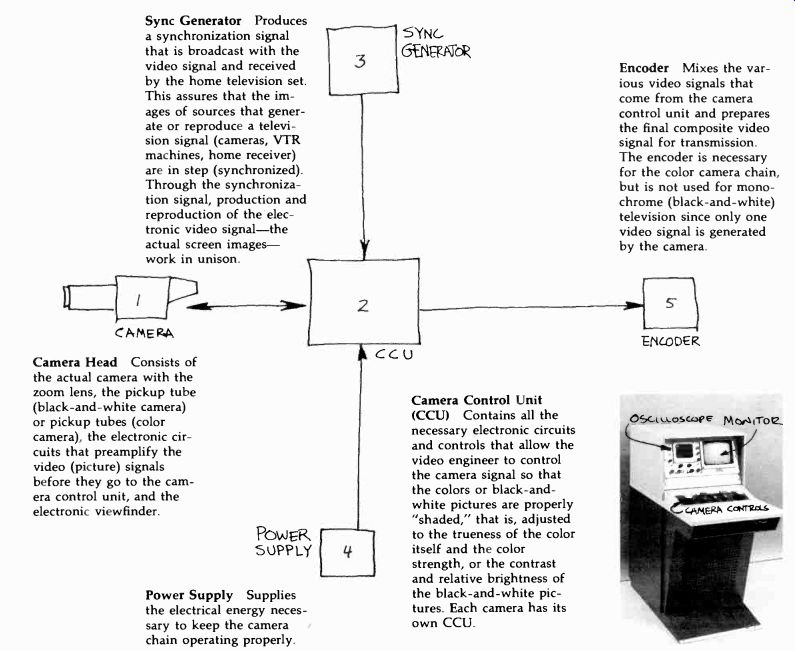
2.4 Camera Chain: The camera chain consists of (1) the camera head, which
is what we ordinarily call the television camera; (2) the camera control unit,
or the CCU; (3) the sync generator; and (4) the power supply. The color camera
has an additional part, (5) the encoder.
The camera control unit (see photo at right) contains the electronic equipment necessary to achieve optimal quality.
---------

2.5 Basic Principle of Television Camera: (a) light reflected off object;
(b) lens gathers light and focuses image of object onto front surface of pickup
tube; (c) camera pickup tube with photosensitive surface that converts light
into electrical energy, the video signal; (d) preamplifier, which strengthens
signal; (e) electronic viewfinder, a small television set that shows what
the camera is photographing. In most color cameras, the viewfinder produces
only a black-and-white picture.
---------
Pickup Tubes
There are two major types of pickup tubes used in monochrome television: (1) the image-orthicon, or I-O, tube and (2) the vidicon tube. The I-O tubes are further classified into the 4 1/2-inch I-O and the 3-inch I-O, indicating the size of the light-sensitive front surface of the tube. The vidicon tubes come in a 2/3-inch, 1-inch (25mm), or 1 1/4-inch (30mm) front surface size. (See 2.6.) Similarly, we speak of 4 1/2-inch I-O, 3-inch I-O, and vidicon cameras. Generally, the I-O cameras deliver higher-quality pictures than the vidicon. Although technically not quite correct, we may compare the different camera pickup tubes with the picture quality of differently sized film. If you make a print from a small negative, such as a 16mm film, you will not achieve the quality you would get from a 35mm or 70mm negative. The vidicon tube surface corresponds approximately to the frame size of a 16mm film therefore vidicon cameras take 16mm-format film lenses-and the 3-inch image-orthicon tube corresponds to the area of a 35mm film frame hence, image-orthicon cameras take 35mm-format lenses. The 4 1/2-inch image-orthicon tube corresponds to an even larger negative and produces, therefore, clearer and better pictures, although 35mm-format lenses are also used for this camera since the image enlargement occurs within the I-O tube.
But the I-O cameras are not without serious disadvantages over the vidicon cameras. In order to show you the basic differences between I-O and vidicon cameras, we will briefly compare their operational and electronic characteristics.
Keep in mind that there are, of course, great quality differences among the various models of both types. Thus it can happen that a high-quality vidicon camera outperforms quite easily a low-quality I-O. Operational Characteristics There are two operational characteristics that are especially pertinent to a comparison of image orthicon and vidicon cameras: (1) size and weight and (2) ruggedness.
====================
Additive Primary Colors
Red, blue, and green.
Ordinary white light (sunlight) can be separated into the three primary light colors, red, green, and blue.
When these three colored lights are combined in various proportions, all other colors can be reproduced.
Burn-in, or Sticking
Image retention by the camera pickup tube. If the camera is focused too long on an object with strong contrast, the picture tube may retain a negative image of the contrasting scene, although another object is being photographed. Occurs especially in I-O (image-orthicon) tubes, or occasionally in vidicons, that have been in use for a relatively long time.
Camera Chain
The television camera (head) and associated electronic equipment, consisting of the CCU (the camera control unit), the power supply, the sync generator, and the encoder (for color cameras only).
Camera Control Unit
Equipment, separate from the camera head, that contains various video controls, including color balance and contrast and brightness. It is operated by the video engineer before camera operation (camera setup) and during camera operation (camera shading).
Camera Head
The actual television camera, which is at the head of a chain of essential electronic accessories. In small, portable cameras, the camera head contains all the elements of a camera chain.
Chrominance Channel
The color (chroma) channels within the color camera. A separate chrominance channel is responsible for each primary color signal-that is, one for the red, one for the blue, and one for the green.
Contrast Ratio
The difference between the brightest spot and the darkest spot in a scene (often measured by reflected light in foot-candles), expressed in a ratio, such as 20:1.
Dichroic Mirror
A mirror-like color filter that singles out, of the white light, the red light (red dichroic filter) and the blue light (blue dichroic filter), with the green light left over.
External Optical System
The zoom lens, or the various lenses on a lens turret.
Falloff
The "speed" (degree) with which a light picture portion turns into its shadow areas. Fast falloff means that the light areas turn abruptly into shadow areas. Slow falloff indicates a very gradual change from light to dark, or little contrast between light and shadow areas.
Foot-Candle
The measure of light intensity, or unit of illumination. The amount of light produced by a single candle on a portion of a sphere one foot away; one foot-candle per square foot is called one lumen. (Foot-candles times the surface area in square feet = lumens.) Grayscale A scale indicating intermediate steps from TV black to TV white. Maximum range: 10 grayscale steps; good: seven steps; poor: five steps.
Image-Orthicon, or I-O
A specific type of pickup tube used in some monochrome cameras.
Internal Optical System
The dichroic mirrors, reflecting mirrors, relay lenses, and color filters inside the color camera.
Lag, or Comet-Tailing
A cometlike smear that follows a moving object or motion of the camera across a stationary object.
Occurs especially with vidicon cameras under low light levels.
Luminance Channel
A signal that is matrixed (combined) from the chrominance channels and provides the black-and-white signal. The luminance channel gives the color picture the necessary brightness contrast and allows a color camera to produce a signal that is receivable on a black-and-white television set.
Monochrome
Literally "one color." In television, it means black-and-white (in contrast to color). Pickup Tube, or Camera Tube The main camera tube that converts light energy into electrical energy, the video signal.
Plumbicon
A registered trademark of N. V. Philips for a vidicon-type pickup tube. Used almost exclusively in good-to high-quality color cameras. Because the Plumbicon has a lead-oxide-coated photoconductive (light-sensitive) front surface, variations of it are sometimes called lead-oxide tubes.
Prism Block
A compact internal optical system that combines the dichroic (color-separating) elements (filters) and light-diverting elements (prisms) all in one small block-like unit.
Relay Lens
Part of the internal optical system of a camera that helps to transport (relay) the separated colored light into a pickup tube.
Resolution
The fine picture detail as reproduced on the video monitor. A high-resolution picture is desirable, since fine detail can be read on the screen.
Signal-to-Noise Ratio
The relation of the strength of the desired video (picture) signal to the accompanying electronic interference, the noise. A high signal-to-noise ratio is desirable (strong video signal and weak noise). Stability The degree to which a camera (or camera chain) maintains its initial electronic setup.
Star Filter
A lens attachment that changes high-intensity light sources into star-like light images.
Subtractive Primary Colors
Magenta (bluish red), cyan (greenish blue), and yellow. When mixed, they act as filters, subtracting certain colors.
Video Noise
A spurious electronic signal that interferes with the desired video signal. Generated unavoidably within the system, it shows up as "snow," white (or colored) spots in the picture.
Video Signal
Electrical impulses (voltage) generated by the camera pickup tube. The amplified video signal provides the necessary information for generating a picture.
Vidicon A type of pickup tube, used extensively in small, portable, monochrome cameras as well as in color cameras.
========================
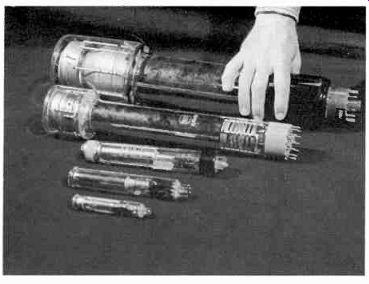
2.6 Television Pickup Tubes (from top to bottom): 4 1/2-inch image orthicon;
3-inch image orthicon; 25mm Plumbicon; 1-inch vidicon; 2/3-inch vidicon.
Size and Weight
Because of the large tubes, the I-O cameras are relatively large and heavy. The 4 1/2-inch cameras, for example, are so heavy that even two strong men have to struggle to mount the camera on a pedestal. Even the smallest of the I-O cameras is difficult to use in the field, and none of them can be carried in the field by one person.
The small vidicon tube and its relatively uncomplicated electronic accessories permit the construction of a variety of vidicon cameras, ranging from the extremely small, low-quality industrial cameras without viewfinders (see page 17) to the rather large viewfinder studio cameras that approach the I-O camera in size and weight (see 2.7). But most viewfinder vidicon cameras that are used for non-broadcast production are small and light enough for one person to handle quite easily.
The vidicon tube, however, has made it possible to produce small viewfinder cameras that can be handled almost like an 8mm film camera.
These highly portable, low-cost cameras and recording equipment have revolutionized television production by liberating it from the exclusive hold of the professional production companies and opening it up to individuals and small groups of interested people. The small, portable camera has democratized television. Community television has developed apace with its advent, and video artists have found it a viable tool for their craft. Unfortunately, the picture quality of these vidicon cameras does not yet meet broadcasting standards (an agreed-upon electronic standard of picture resolution and strength). However, under ideal circumstances, they can produce pictures that are good enough to be broadcast, especially when dubbed up to 2-inch videotape and electronically corrected-with a device called a time-base corrector (see pages 221-222)-during the dubbing.
Ruggedness
The I-O tube, as well as the whole I-O camera, is much more temperamental electronically and sensitive to shock and rough handling than the vidicon camera. When the I-O camera is warm, moving it over rough terrain or taking it off the pedestal is inadvisable. The vidicon, on the other hand, will withstand a reasonable amount of jolting while in operation. Of course, you should always treat any camera as gently as possible, especially when you are working with it away from the studio.
Electronic Characteristics
The basic electronic characteristics of I-O and vidicon cameras particularly important in the context of production are: (1) picture quality and stability, (2) operating light level, (3) burn-in, and (4) contrast range.
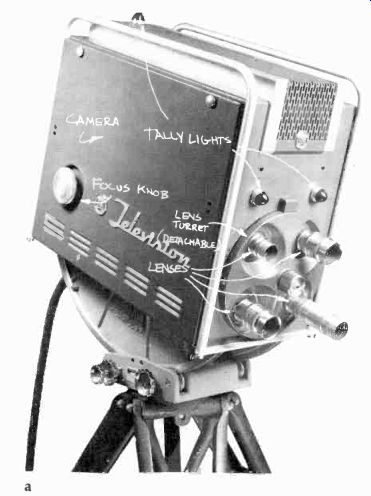
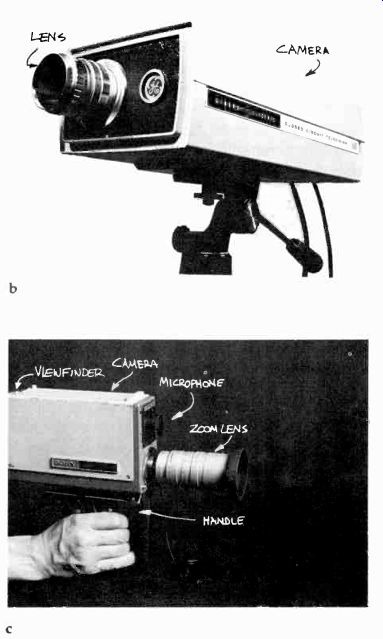
2.7 Vidicon Cameras: (a) RCA-TK 15 vidicon camera, a viewfinder studio camera;
(b) General Electric industrial camera, a type used for closed-circuit observation;
(c) Sony "portapak" camera, a highly portable camera used in conjunction
with a small 1/2-inch videotape recorder.
Picture Quality and Stability
The popularity of the I-O camera in on-the-air telecasting stems from its superior picture quality. And since picture quality is the single most important criterion in the performance of a camera, the I-O camera kept its supremacy until the advent of color.
Picture quality means basically that we can see fine detail in the television image and that there are strong blacks and whites with a sufficient number of easily distinguishable grays between them. Technically, the television picture should have high resolution, which means that the television system is capable of reproducing extremely fine object detail. The picture should also display high contrast that is, deep blacks and brilliant whites, and a good grayscale-a good number (up to 8) of easily distinguishable brightness gradations of grays that lie between the television black (darkest screen area) and television white (brightest screen area). Furthermore, the picture should be as "quiet" as possible, which means that it should be as free from video noise as possible. A "noisy" picture has a great amount of snow, white vibrating spots in the picture that occur when the video signal as produced by the pickup tube is not strong enough to override the electronic interference, which the system usually and unfortunately generates.
Video noise works very much like audio noise.
Even the best high-fidelity system has some inherent electronic noise. You can hear the speakers hum a little as soon as you turn on the amplifier.
Or, when the music is very low (which is equivalent to a weak audio signal), you may become aware of the rumble of the turntable. As soon as the music gets louder again (equivalent to a stronger audio signal), you are no longer aware of the noise. The relation of the strength of the picture signal to the accompanying interference, the noise, is generally expressed in a signal-to-noise ratio.
A high signal-to-noise ratio is desirable. It means that the signal is high (strong) relative to the noise under normal operating conditions.
Finally, the picture should generally not display any lag, or comet-tailing, also called "smear" and "following image." A lag shows up as a cometlike smear that follows a moving object, or motion of the camera across stationary objects.
Lag occurs especially in vidicon cameras under low lighting conditions, and when the object is very bright against a dark background.
As pointed out before, the I-O camera does well in most respects. Most importantly, it produces a higher resolution image than the vidicon.
The contrast is adequate in the I-O, although more limited than the vidicon. We will take up contrast and grayscale response of the I-O and vidicon cameras in a separate paragraph. Although the vidicon tube is basically quieter than the I-O tube, the superior resolution of the I-O tube and its ability to produce a fairly strong signal even under low light levels make up for this deficiency. The vidicon tube is highly susceptible to comet-tailing, while the I-O tube is virtually free of it.
Picture stability means that once the camera has been properly adjusted it should need little or no further adjustment for some time (up to the whole day of telecasting). Before a camera becomes fully operational, it has to be "set up," or aligned. Any camera, except for the rather uncomplicated vidicon cameras, including the portable ones, needs to warm up before the video engineer can begin with alignment procedures. The longer the warmup period, the better the alignment will be, and the less the camera will get out of adjustment later on. Unfortunately, many production people do not realize the importance of the warmup period and call for pictures before the camera is warm enough to operate. Especially in the beginning of the broadcast day, the schedule should take this warm-up time into consideration-half an hour is considered minimum for I-O cameras, and one hour is generally sufficient.
Color cameras, however, take even longer to warm up. Depending on the sophistication of the vidicon camera, it may need as little as five minutes (for the portable models) to one hour for the studio models.
After the warmup time, the video engineer will check various aspects of picture quality, such as resolution, contrast, and grayscale response with a test chart and a waveform monitor, also called an oscilloscope. Vidicon cameras will keep such an alignment for several days, even after they have been turned off and on several times. I-O cameras, however, are more temperamental.
Often they need to be realigned even after a relatively short telecast. I-O cameras have a tendency to "drift" and therefore need constant attention.
Operating Light Level
To perform at peak efficiency, every television camera needs a certain amount of light. Picture quality will suffer if the camera is used under lighting conditions that are below a certain operating level. When the tube is not receiving enough light energy, it will turn out a video signal that is too weak to drown out the video noise. What, then, is the proper operating light level? For most I-O cameras, the operating light levels generally range from 75 to 100 footcandles. Vidicon cameras need approximately twice the amount of light as I-O cameras, from 150 to 250 foot-candles. (We will discuss light levels more thoroughly in Section 5). Burn-in Like light bulbs, television pickup tubes have a limited service life. I-O tubes have a shorter service life (usually 1,000 hours) than vidicon tubes (well over 2,000 hours). The older an I-O tube gets, the more sensitive it becomes to "burn-ins" or "sticking." A burn-in means that the tube remembers the picture it has taken and carries a gray negative image of that particular picture over the following shots. This rather annoying picture retention is caused especially when you focus the camera on a scene for an extended period with no movement of either the camera or object, or by focusing on a scene with strong black-and-white contrast, such as a black studio card with white lettering on it. With an old I-O tube in your camera, you can burn in the opening title of the show and carry the burn-in over several of the shots following.
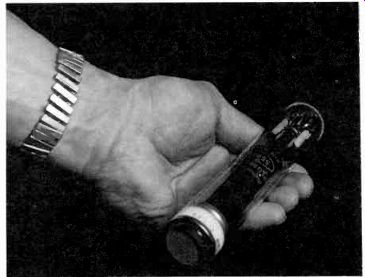
Fig. 2.8. 30mm (1.25 inch) Plumbicon Tube.
Vidicon tubes are comparatively insensitive to burns and can be focused on high-contrast stationary objects for a relatively long time. But once a burn-in has occurred in a vidicon tube, it is more difficult to remove its traces than from an I-O tube. If a burn-in has occurred in an I-O tube, you can remove it in most cases by panning your camera back and forth on a well-lighted, neutral surface, such as the studio floor or the cyclorama.
Contrast Ratio
The image-orthicon tube is highly sensitive to extreme black-and-white contrast. A somewhat limited contrast range will greatly enhance picture quality. Generally, I-O tubes cannot tolerate a contrast ratio that exceeds 20:1, that is, the brightest spot in your scene should be only twenty times brighter than the darkest spot. If the scene exceeds this limit, the video operator will have to adjust the picture either to reduce the bright spots, thereby rendering the darker areas uniformly black, or to lighten the dark areas, thereby overexposing and washing out the light areas. However, if you show nothing but a variety of medium grays in your scene, your picture will, indeed, look "medium." There is nothing wrong with using dark colors in your set, so long as you don't put something extremely bright and highly reflecting directly in front of or adjacent to them. As a matter of fact, your video operator will probably appreciate having something white and something black in the set so that he has a reference for his shading adjustment.
Reflections off extremely bright objects, such as jewelry or brass instruments, that exceed the tolerance of the tube will cause "blooming" or "halo" effects. Blooming shows up as a black rim or halo around the reflecting object. Besides looking bad, it is quite harmful to the I-O tube. Because of this light sensitivity, you should never point the I-O camera into bright lights and obviously not into the sun. Even a few seconds of focusing on a bright light may cause the I-O tube to burn out or to be damaged beyond repair.
Vidicon tubes generally tolerate a higher contrast (up to a 30:1 ratio) and are less subject to blooming. But they, too, will burn out if the camera is focused for any length of time into a bright light. But even with the vidicon's greater tolerance to brightness contrast, it is easier to get better picture quality if you maintain a 20:1 limit in your scene. An extreme brightness contrast will additionally emphasize the falloff characteristic of the vidicon tube. While in the light areas, the vidicon camera can produce beautifully subtle and distinct shades of gray, in the shadow areas it has a tendency to see everything uniformly dark. The vidicon tube has a fast falloff and therefore does not differentiate well between light and very dark shadow areas. The I-O tube has a more evenly spaced falloff and shows, within the specified contrast range, equally spaced grayscale steps even in the darker end of the scale.
The Color Camera
The color camera works on the same fundamental principle as the monochrome camera: the conversion of light into electrical energy. But color television is technically much more complex than monochrome television. A knowledge of some of the basic workings of the color camera will help you greatly in understanding the specific production techniques for color television. We will, therefore, briefly discuss these basic points: (1)
Plumbicon pickup tube, (2) chrominance and luminance channels, (3) internal optical system, (4) operational characteristics of the color camera, and (5) electronic characteristics of the color camera.
[1. Plumbicon is a registered trademark of N. V. Philips.]
Plumbicon Pickup Tube
All newer model broadcast quality television cameras use Plumbicons tubes. Manufactured under various trade names, the Plumbicon tube is basically an improved vidicon tube. Contrary to the vidicon, it has a lead-oxide-coated photoconductive (light-sensitive) front surface, and otherwise improved light-converting elements. Sometimes the Plumbicon tubes are simply called "lead-oxide" tubes. Plumbicon tubes come in a 1-inch (or 25mm) format, or the more widely used 11/4-inch (or 30mm) format (see 2.8). Many lower quality color cameras use the standard vidicon tubes or smaller format Plumbicon tubes (such as 2/3 inch). In most cases, the vidicon and Plumbicon tubes are interchangeable with only minor electronic adjustments in the camera.
Chrominance and Luminance Channels
While in the monochrome camera the light, as caught by the camera lens, is focused directly into the single camera pickup tube, the color camera first splits the entering light into the three primary colors: red, green, and blue (see color plate II). Each one of these is then focused individually on a separate pickup tube: one for the red light, one for the green light, and one for the blue light. In effect, we have three cameras, or channels, in the color camera in order to produce and process three individual video signals, a "red" signal, a "green" signal, and a "blue" signal. Since these channels process the primary colors, they are called chrominance channels (from the Greek chroma = color). In the older color camera, there used to be a fourth tube and channel that produced the necessary brightness differentiations (from black through various shades of gray to white-see grayscale in Section 12). This channel, which provides the color picture with the necessary brightness differences, is called the luminance channel (from the Latin lumen = light). In the present cameras, the luminance signal does not require a special pickup tube but is produced by matrixing (combining) the red, green, and blue signals again into a monochrome (black-and-white) luminance signal.
The green signal, which carries a great amount of image detail, is often used for an electrically generated effect that gives the appearance of increased picture resolution and therefore of a sharpened image. This effect, called "contours-out-of-green," gives the color picture crispness and snap.
Internal Optical System and Color Separation
The light as gathered by the lens is separated by a series of dichroic (color-separating) mirrors into the three primary colors of light (see color plate Ill). The dichroic mirror Dl splits off the red color from the incoming light, letting the green and blue light pass. Dichroic mirror D2 splits off the blue color, letting the remaining green color pass.
Regular high-quality mirrors (M1 and M2) reflect the separated colored lights into their respective pickup tubes.
The relay lenses (R1, R2, R3) help to transport, relay, the three separate colored light images to the pickup tubes. The lenses help to keep the images sharp and clear until they reach the pickup tubes.
The filters (F1, F2, F3) keep out all unwanted light that might interfere with each of the primary colors, red, green, and blue.
The camera pickup tubes (P1, P2, P3) may be Plumbicon or vidicon or any combination thereof.
High-quality cameras usually have an "extended red" Plumbicon tube, which is designed especially to convert the red light into the video signal of the red channel with a minimum of distortion, and "separate mesh" Plumbicon tubes for the green and blue channels. The separate mesh tubes virtually eliminate comet-tailing, or lag.
Because the mirrors and relay lenses take up a considerable amount of light before the colors reach the pickup tubes, and because the alignment of the mirrors and the lenses is obviously quite critical, another, more efficient, internal optical system is used in many color cameras. This system combines the dichroic, color-separating elements (filters) and the light-diverting elements (prisms) all in one small beam-split prism block (2.9; see also color plate II). Since the pickup tubes can be attached directly to the prism block, relay lenses are no longer necessary.
Operational Characteristics
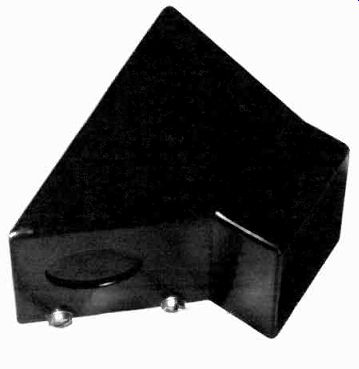
2.9 Prism Block.
The major operational characteristics of the color camera are (1) size and weight, (2) ruggedness, and (3) type of cable.
Size and Weight
Because the color camera is actually three cameras in one, it is obviously quite heavy and bulky. A high-quality studio camera cannot be carried by one person, and it takes at least two persons to move one onto or off of a studio pedestal or tripod.
Some portable color cameras can be carried and operated by one person, but even these stripped-down models are bulky and tiresome when carried for any length of time.
There are small portable color cameras on the market that have only two pickup tubes, and in some instances only one. In the two-tube cameras, chrominance channels for only two of the primary colors are provided, the third color being electronically derived from the leftover signal, which by necessity must represent the third primary color. In the one-tube color camera, the front surface of the special pickup tube is covered with vertically striped filters that separate the incoming light into the primary colors. However, what is gained in portability and ease of operation is often--but not always--lost in picture quality and stability. Constant efforts are being made to develop a portable color camera that is extremely light and easy to operate and that will produce high-quality pictures. (See 2.11.)
Ruggedness In general, its intricate internal optical system makes the color camera quite vulnerable to physical shock. Although the portable cameras are a little more rugged than studio cameras, they too can be easily jolted out of adjustment, especially those that use the dichroic mirror system instead of the prism block. Since the three channels make the color camera particularly sensitive to alignment, be extremely careful in moving the camera at the end of the warmup period and while it is in operation.
==========================
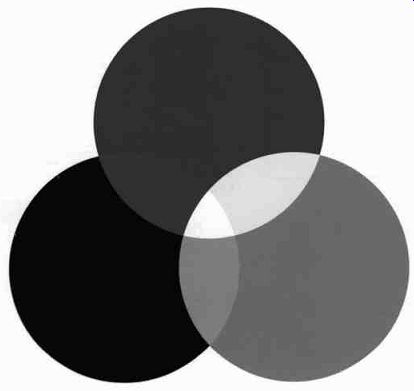
---- Plate I When mixing colored light, the additive primaries are red,
green, and blue. All other colors can be achieved by mixing certain quantities
of red, green, and blue light.
For example, the additive mixture of red and green light produces yellow.
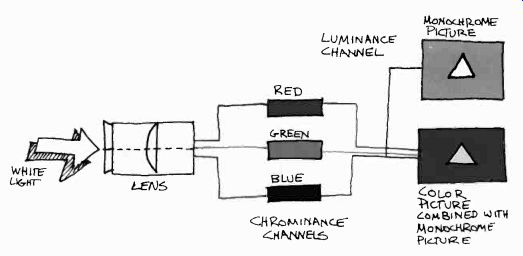
Plate II--The light that enters the camera is divided into the three additive
primaries and treated separately as red, green, and blue signals. In a three-tube
camera, each tube creates a separate video signal for each primary color.
The chrominance channels (color signals) produce the color picture, and the
luminance channel (a combination of the color signals) the black-and-white
picture.
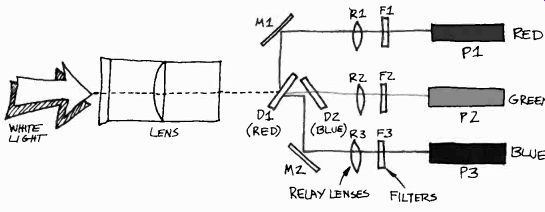
--- Plate III White light enters the camera through the lens and is split
by dichroic mirrors into red, green, and blue light. These three light beams
are directed through regular mirrors and relay lenses into three camera pickup
tubes: one each for the red, green, and blue light. Special filters correct
minor color distortions before the light beams enter the tubes.
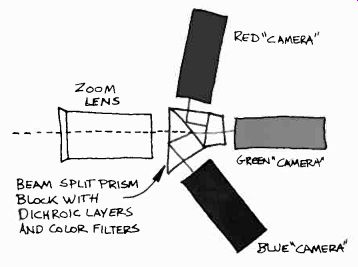
Plate IV Most color cameras use a beam-split prism block instead of dichroic
mirrors for their internal optical system. The incoming white light is split
and relayed into the three pickup tubes through dichroic layers and color
filters.
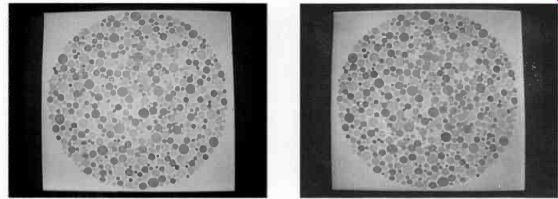
--- Plate V Since the black-and-white camera responds primarily to the
brightness attribute in color (and not to hue and saturation), the black-and-white
camera is color blind. It cannot detect differences in hue when the brightness
remains the same.
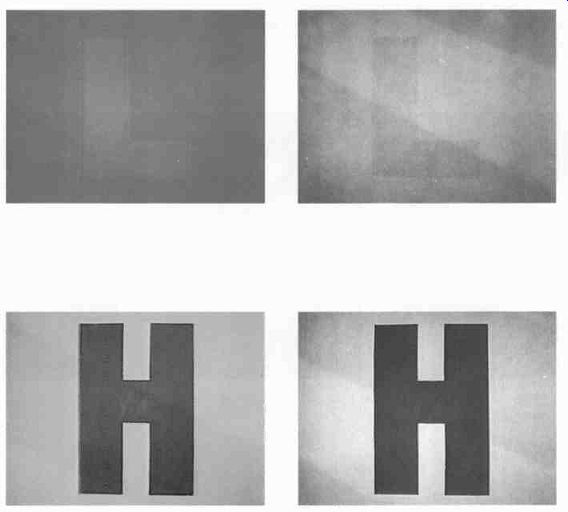
Plate VI Although the hue is sufficiently different for this letter to show
up on color television, it is barely readable on a black-and-white monitor.
The brightness contrast is insufficient for good monochrome reproduction.

Plate VII The lettering on this card has enough hue and brightness contrast
to show up equally well on a color and black-and-white television receiver.
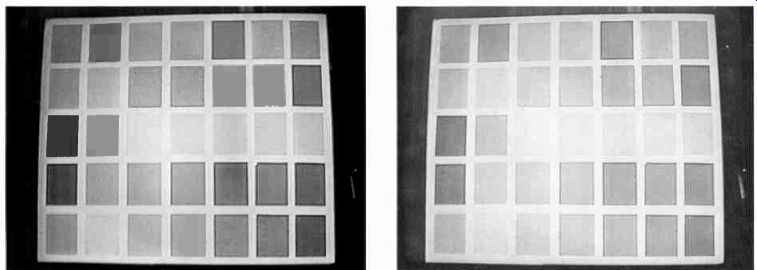
-- Plate VIII The colors on the left appear on the monochrome monitor as
shown on the right. Note which colors appear as the same gray (same brightness)
and which are distinctly different. It is the brightness variation, not hues,
that makes colors appear as different grays on monochrome television.
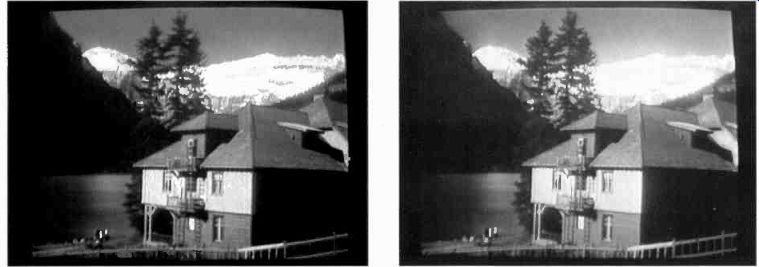
Plate IX Because of brightness contrast, this slide reproduces equally well
on color and black-and-white television.
============================
----------------------------

2.10 Ordinary white light, like sunlight or the light from a light bulb,
can be separated into three basic, or primary, colors: red, green, and blue.
Obviously, when we mix the three primaries together again, we get white light.
But we can also mix these three primary colored lights in various proportions,
that is, various light intensities, and achieve almost all the colors we ordinarily
perceive. For example, take three slide projectors and put a clear red slide
(filter)
in one, a clear green one in the second projector, and a clear blue one in the third projector. Then hook each of the slide projectors to a separate dimmer.
When you have the dimmers up full (assuming equal light transmission by all three filters) and shine all three light beams together on the screen, you get white light, as we mentioned before. Full-strength red and full-strength green will give you yellow. But if you now dim the green projector a little, the yellow will turn orange. If you dim the red instead of the green projector, you will get a brownish color. The blue and red together will yield a reddish purple, called magenta. This mixing process of colored light is called additive color mixing. When we mix paints of two colors together, however, they filter each other out and form a new color. They subtract each other's wavelength. This process is, therefore, called subtractive color mixing. The subtractive primary colors are magenta (a bluish red), cyan (a greenish blue), and yellow. Since it is light, not paint, that enters the camera, color television operates with the additive color-mixing process.
In color television, the light entering the lens is split into the three additive primaries, red, green, and blue, and processed by three separate channels, the chrominance (color) channels, which act very much like the three slide projectors. In the receiver, the screen is lined with many dots arranged in groups of red, green, and blue. These are activated by three "slide projectors," called electron guns, each one hitting with its beam all the dots representing one particular color-all the red dots, all the green dots, or all the blue dots. By changing the intensity of one, or all, of the beams, you can create a variety of colors. If all three beams activate the dots fully, you get white; if the guns are turned off, you get black. If only the guns that activate the red and the green dots fire, but not the one that activates the blue, you get yellow. Since the color dots lie very close together, you perceive them as various color mixtures. *
[* Herbert Zettl, Sight-Sound-Motion (Belmont, Calif.: Wadsworth Publishing Co. 1973), pp. 58-83.]
----------------------------
Type of Cable
Depending on the electronic design of the camera chain, various types of cable must be used from camera head to the CCU. The continual quest for lighter and more compact television makes the weight of the camera cable an important operational consideration. Obviously, the lighter the cable, the easier it is to handle. The standard television cable for monochrome cameras and some color cameras (called the TV-81 cable) is quite heavy. Through computer-type digital control circuits and multiplexing techniques (putting more than one signal through the same wire), a very light triaxial cable (which has only three concentrically arranged wires) can be used. Philips Broadcast Equipment Corporation, which makes such digitally controlled color cameras, gives an interesting weight comparison between the standard and triax cables: 5,000 feet of the standard TV-81 cable weighs 4,370 pounds, while the same length of triaxial cable weighs only 333 pounds. Of course, the increased complexity of the circuit design makes such cameras, once again, more of a liability electronically than the standard cameras.
Electronic Characteristics
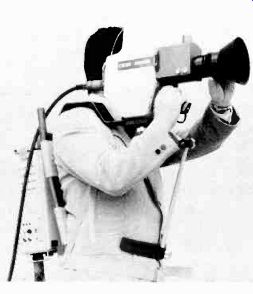
2.11 High-Quality Portable Color Camera (Philips LDK-11).
The electronic characteristics of the monochrome camera are equally relevant for the color camera.
We will, therefore, look briefly at (1) picture quality and stability, (2) operating light level, (3) burn-in, and (4) contrast range.
Picture Quality and Stability
The Plumbicon tube lacks the resolution power of the I-O tube. Fortunately, the color differentiation helps to distinguish between smaller picture portions and to define object contour. Like the vidicon, the Plumbicon tube is fairly quiet, which means that it has a favorable signal-to-noise ratio. However, the picture quality deteriorates drastically if the tubes do not receive a sufficient amount of light.
If you have to worry about aligning three tubes instead of one, you will obviously have more potential alignment drifts (the camera drifting out of setup values), than you would with a one-tube camera. However, when given enough warmup time, the color camera is no more critical in alignment than an I-O camera, for example.
The one rather serious drawback of the Plumbicon tube has been its problem of faithfully reproducing highly saturated (strong) reds. The cooler reds (bluish reds) and the strong, dark reds are notably susceptible to distortion. The rather expensive "extended red" Plumbicon is more capable of reproducing reds without distortion than the regular Plumbicon tube, but even the more costly one has some problems with reproducing highly saturated dark reds without distortion.
When vidicon tubes are used in the color camera, the electronic characteristics are much the same as for the black-and-white camera.
Operating Light Level
Most color cameras need from 200 to 400 foot-candles of illumination to produce optimal pictures. You will hear and read that a camera can produce a good color picture (called "full video," which means that the video signal has a certain prescribed intensity) with as little as 5 foot-candles of illumination through "bias lighting" (an electronic intensity booster). This is true as long as your video operator has the time, skill, and energy to go through a precarious color-balancing act, and as long as you don't have a high-contrast, fast-moving scene. An average illumination of 250 foot-candles will make the camera and everyone who works with it considerably more effective.
The normal Plumbicon tube, like the vidicon, produces comet-tailing, or lag, under low lighting conditions. You may have seen this effect during the televising of a football game: the player who runs from a brightly lighted area of the field to a shadow area and suddenly seems to be trailing a ball of fire. Although in this case such an effect may accurately symbolize the player's power and emotion, comet-tailing is not always so appropriate. As indicated before, the "separate mesh" Plumbicon tube reduces this sort of lag to a large extent. The best assurance against comet-tailing is still a sufficient amount of light.
Burn-in
The Plumbicon tube is virtually free of burn-in and can tolerate a high-contrast scene for a fairly long period without any trace of image retention.
Contrast Ratio
The contrast range of the Plumbicon tube is quite close to that of the vidicon tube. Generally, the Plumbicon tube can handle a contrast up to 30:1 without danger to the tube itself. However, if you want clear, undistorted colors, the color camera, too, should not be exposed to a contrast that exceeds the 20:1 ratio.
The primary reason for this narrow range is that one of the most important colors requiring true reproduction is the skin tone. When using color chips, you may be able to balance your colors against one another even within a contrast range of more than 30:1, that is, where the brightest color is more than thirty times brighter than the darkest color. However, within such a high-contrast range, you may have to shade the lighter colors down a little (make them darker than they really are) in order to differentiate among the darker colors; or you may have to bring the darker and mid-range colors up a little in order to compensate for the brighter ones. But you can't do this with a face. You can't shade skin tones lighter or darker simply to adjust for the surrounding colors. Skin tones have, after all, a fixed color standard that suffers noticeably from the slightest distortion.
Besides electronic shading devices, the color camera, like the broadcast-quality black-and-white camera, has a filter wheel that can hold a variety of neutral density filters, color filters, or special effects devices, such as star filters. The neutral density filters act like sunglasses of varying density. They simply reduce the amount of light that falls on the pickup tubes without distorting the actual colors of the scene. The color filters also help to correct color distortion. (See 2.12.) Contrary to the I-O and vidicon tubes, the Plumbicon tube is virtually free of the halo effect, or blooming, when subjected to highly reflecting objects. In fact, dazzling jewelry or brass instruments lend the picture energy and sparkle. You can even point the Plumbicon color camera directly into the studio lights without damaging the tubes themselves. What used to be an annoying problem with the I-O cameras has now been made into a virtue in color production. Most color cameras come equipped with a variety of star filters, which transform any bright light source into star-like light beams with four, six, eight, or however many points the star filter is made to produce. (See 2.13.) Types of Cameras There is a bewildering array of television cameras on the market. Their names and the way they are classified seem equally confusing. Some are classified by what they are primarily able to do, their function; others by how good they are, their quality. Still others are named for the type of pickup tube, or whether they have a lens turret or a zoom lens.
The simplest way to keep them straight is to classify them according to their function-what they are supposed to do or how they are principally used.
We will, therefore, distinguish among three broad types of cameras: (1) broadcasting and non-broadcasting, (2) monochrome and color, and (3) studio and portable.
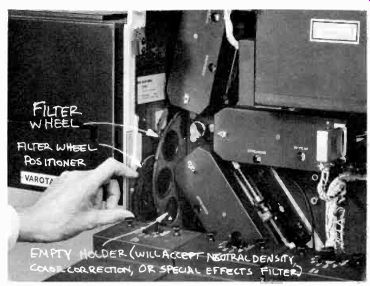
2.12 Filter Wheel: The filter wheel can hold a variety of neutral density
or color correction filters. In some cameras, the filter wheel can be turned
by remote control.
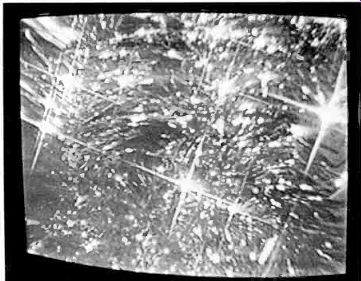
2.13 Star Filter Effect: The star filter changes extremely bright light sources
into four-, six-, or eight-point starlike light beams.
Broadcasting and Non-broadcasting Cameras
What we ordinarily call "broadcast quality" refers to cameras that are intended for open-circuit, on-the-air telecasting. Non-broadcast cameras are used for closed-circuit transmission, which means that the transmission process does not use public airwaves. Closed-circuit television includes any type of surveillance by television, self-contained distribution of television material in educational institutions, medical centers, or business establishments, or even the CATV (Community Antenna Television; in short, cable television) productions, which are distributed via cable from the CATV studio directly to the wired homes.
Broadcast quality means that the camera chain must deliver a picture that fulfills certain established engineering standards-as written by the EIA (Electrical Industries Association) and the FCC (Federal Communications Commission). But there is still a great difference between the top-priced broadcast television camera and the medium-priced broadcast camera. The top camera has several automatic correction circuits built in that make the camera function at peak efficiency even under adverse conditions. The medium-priced camera, on the other hand, works quite well under ideal production conditions, such as the availability of a great amount of even lighting and simple colors. But as soon as a production becomes a little more demanding-in the way of high-contrast lighting, subtle differences in colors, precise rendering of skin tones, and so forth--the medium-priced camera can no longer keep pace. With all but the top broadcast cameras, even a fast zoom in or out may cause noticeable color distortions.
Non-broadcast cameras have no regulated performance standards. They are judged merely by how well they do the job for which they are designed. For example, there is no need to worry about a high-quality picture if the only requirement for the camera is to watch cars in a parking lot. But if the closed-circuit camera is used for instruction in a broadcasting course, or for showing a delicate operation to a number of medical students, top picture quality and true color renditions are essential.
Monochrome and Color Cameras
One of the most obvious differences in function is whether the camera should deliver a black-and-white picture or color, or both. Color cameras must, by law, be able to produce compatible color; that is, the color signal must be convertible into black-and-white images on a monochrome television set.
Almost all broadcast cameras used in television stations throughout the developed countries are color. Of course, many black-and-white television cameras are still used in closed-circuit operations, such as educational systems in schools and industry; and open-circuit broadcasting is occasionally done in black and white. (Unfortunately, color is used rather indiscriminately regardless of aesthetic appropriateness. In many instances, it is not only unnecessary but often detrimental to communicating emotional intensity and depth. 2)
Monochrome cameras are, therefore, far from obsolete. For the student of television production, the monochrome television camera is obviously the first logical step. For the television artist, monochrome television represents a means of expression whose graphic potential we have scarcely recognized, let alone tapped. (See 2.16.) While all color cameras (with the exception of some small industrial color cameras used for observation only) have zoom lenses, the monochrome camera has either a zoom lens (zoom camera) or one or more fixed-focal-length lenses that are attached to a lens turret (turret camera). (See 2.3). As indicated earlier, monochrome cameras are generally classified by the pickup tube they use.
Thus, we have image-orthicon, or I-O, cameras and vidicon cameras, the latter commonly used for closed-circuit operations.
[2. Herbert Zettl, Sight-Sound-Motion (Belmont, Calif.: Wadsworth Publishing Co. 1973), pp. 92-93.]
---------------

2.14 New products in the television equipment market reflect the continual
striving for broadcast-quality cameras that are extremely light and compact
and that perform well under a great variety of production conditions. One
innovation is the use of an extremely light camera cable for computer-type
digital circuitry and signal-multiplexing. Attempts are also being made to
automate the camera as much as possible. This means incorporating in the camera
mechanism many functions that were previously performed by either the camera
operator or the video operator at the CCU.
You can compare the automated television camera with an automated 8mm movie camera, which will do practically anything for you except the looking.
All you do is pop the film cassette into the camera, point it in the desired direction, and press a button. The camera will look at the scene you are filming, read the reflected light, and adjust the lens iris for correct exposure; and while you do your dramatic zooming in and out, it will keep in focus. If the scene is too dark for the film you are using, the camera will tell you. The professional film maker might scoff at such automation; but the person using such a camera will nevertheless enjoy properly exposed, clear, technically professional-looking movies.
The same goes for automated television color cameras. The more the technical functions, such as color and brightness controls, are taken over by the camera, the more attention you can devote to the event itself and to the aesthetics of your interpretation of it. While technical adjustments can very well be done by the machine (the camera chain), the aesthetics of communication is truly a human function.
Of course, if aesthetically you decide to go against the technical standard as programmed into the camera, you must then have an opportunity to override the automation. If, for example, you want color distortion to emphasize a particular mood, you must be able to tell the camera not to worry and not to self-adjust for standard color balance. Otherwise, both the camera and you will have lost an important creative potential.
---------------
---------------
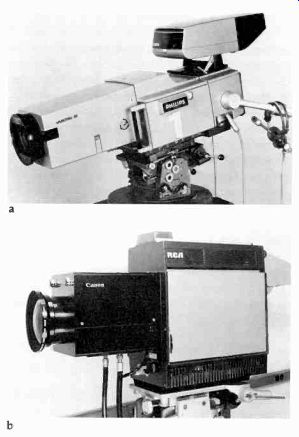
2.15 Color Cameras: (a) Philips LDK-5 (top quality); (b) RCA TK-45A (top
quality); (c) IVC 7000P (broadcast-quality portable); (d) CEI-280 (good quality);
(e) Akai VC-150 (non-broadcast color portapak).
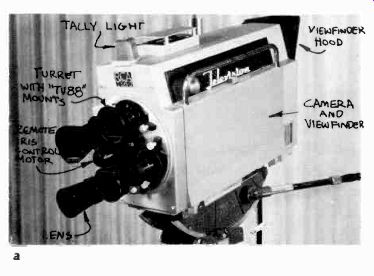
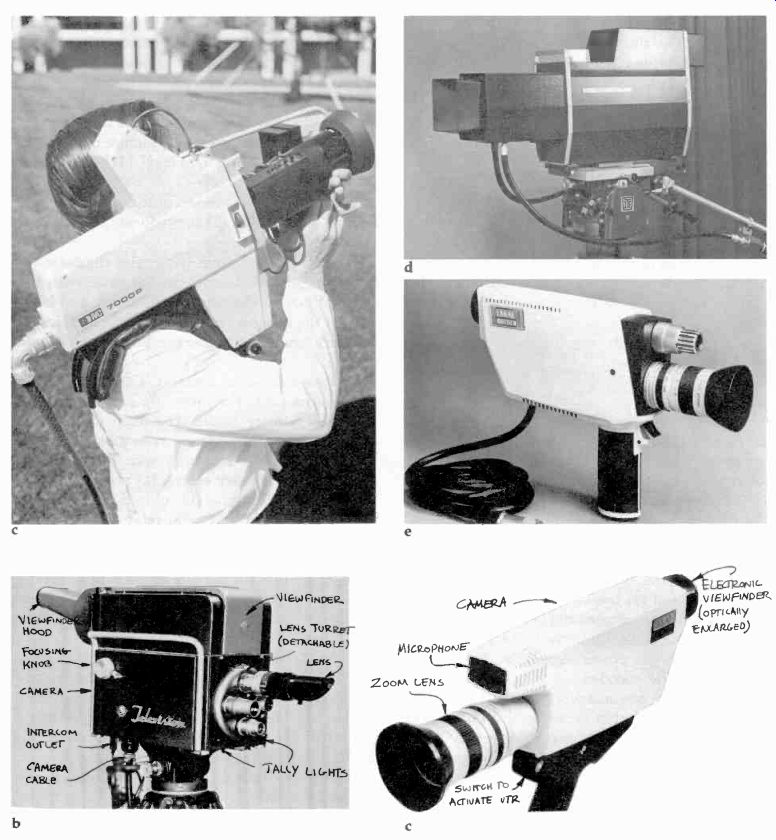
2.16 Monochrome (Black-and-White) Cameras: (a) RCA TK-60 4 1/2-inch image-orthicon
camera (top quality); (b) RCA TK-11 3-inch image-orthicon camera (good quality),
industry standard for a long time; (c) Akai VC-115 portable vidicon camera,
used in conjunction with a 1/4-inch videotape deck.
----------------------
Studio and Portable Cameras
The name "studio camera" is somewhat misleading since the studio camera can also be used in the field. However, the term is used to describe a high-quality camera that is so heavy it cannot be maneuvered properly without the aid of a pedestal, or some other type of camera mount. A more appropriate name would be pedestal camera, since we could distinguish it more readily from the portable camera, which can be carried around by its operator.
The portable camera has obviously many operational advantages over the studio camera. It can be carried and operated by one person, needs no camera mount (you are the mount), and is highly maneuverable. Wherever you can walk, the camera can go. The studio camera, once fairly portable, has unfortunately become so laden down with production accessories, such as the bulky teleprompter, camera lights, and the like, that it can hardly be moved at all.
Such bulk, and the convenience of the zoom lens, entices many a camera operator to let the camera sit as though it were bolted to the ground, thereby drastically reducing its production potential.
On the other hand, as mentioned earlier in this section, the portable camera has liberalized television as to production technique and, in conjunction with refined videotape editing techniques, has become a formidable competitor to film.
Summary
The television camera is one of the most important single production elements. Most other elements in the process are greatly influenced by what the camera can and cannot do.
The camera head, which we ordinarily refer to as the camera, consists of (1) the lens and attachments, sometimes called the external optical system, (2) the camera itself with the pickup tubes, or tube, and attachments called the internal optical system, and (3) the viewfinder.
The camera chain consists of (1) the camera head, (2) the camera control unit, or CCU, (3) the sync generator, (4) the power supply, and, for color cameras, (5) the encoder.
All television cameras work on the same basic principle: the conversion of an optical image into electrical signals, which are reconverted by a television set into visible screen images-the television pictures.
There are black-and-white, or monochrome, television cameras, and color cameras. Monochrome cameras use two major types of pickup tubes: the image-orthicon, or I-O, and the vidicon.
Color cameras have as their main pickup tubes either Plumbicon tubes (a modified vidicon tube with a lead-oxide front surface), or vidicon tubes.
The pickup tube used in the camera head, and the electronic accessories determine the basic electronic characteristics of the camera: (1) picture quality and stability, (2) operating light level, (3) burn-in, and (4) contrast range.
The operational characteristics of the camera include (1) size and weight, (2) ruggedness, and (3) type of cable.
Color cameras contain two major channels: (1) the chrominance channel, which deals with the three primary light colors, red, green, and blue, and (2) the luminance channel, which deals with the dark and light areas, the brightness, of the picture.
In three-tube color cameras, a complex internal optical system splits the incoming white light into the three primary colors. The main parts of the system are (1) dichroic mirrors or a prism system with dichroic filters, which split the incoming light into the primary colors; (2) regular mirrors, which deflect the separate colored light into the respective pickup tubes; (3) relay lenses, which help to keep the image sharp and clear until it reaches the pickup tubes; (4) color filters, which correct the color for the pickup tubes; and (5) the vidicon or Plumbicon pickup tubes themselves.
In large, professional cameras, three tubes are used, one for each primary color. There are also two-tube cameras, in which only two primary colors are used, with the third one being reproduced electronically. In the one-tube color camera, the surface of the pickup tube is striped vertically with a series of extremely narrow filters that divide the light into the primary colors.
Television cameras are grouped by various criteria, such as broadcast or non-broadcast cameras, color or monochrome cameras, studio or portable cameras.